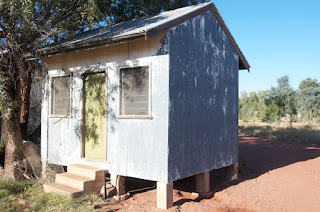
Shearers quarters.
Last post I spoke of the people of Thurloo Downs, and their pivotal role in its pastoral history. However, everywhere you look lies evidence of an older people- Aboriginal heritage- spear heads, rock knives. You walk over it -unaware. But they still exist, in the landscape, in the colour of the soil, in trees and grasses. We, as Australians need to embrace it. This soul this place has. One cannot exist without the other.

Original Building. Circa 1880-Plummer Cotter and family would have known this home.
The buildings we as "white fellas" put in place for me are comforting. From one of the first dwellings, to the managers hut, the shearers quarters, the shearing shed and finally the grand old home. Total functional statements of achievement and pure hard work. Irish men and women blending and bending with the terrain, to form a unique bond. A bond even I could feel. If you read this and have Irish heritage in Australia- chances are you have dark blood in your veins too. Be proud.

Overseers Hut.
I wondered about, and felt the history in every sense. From the start- those aboriginal men and women, the "development' ( do we really "develop" anything?), right through to today. The shearing shed was built in 1928. Every beam numbered to a corresponding beam. Every joint bolted and riveted. A testament to British engineering. This shed could be pulled down and rebuilt exactly as it should anywhere on the property.

Managers Hut.
Being a working station the shed is full of wool, lanolin, and the grease of the men who worked there- turn on the lights and its ready to go for next season.
The shearers quarters not so- Its hard to get men to work now, and harder to maintain the the old buildings.. and they require a lot of it.
I wandered past the old tennis court- I could hear the "thwak" of a tennis ball on cat gut, I wandered past the tack shed, and the remains of a veggie patch. I thought of the Chinese gardener.

Donkey Heater ( email me for details!)
You see, this is a place where the machinery of man come second to the well being of the stock. We need to get back to this grass roots approach. Where a stockman can sleep in the sand and stare at the stars, knowing the stock will be ok because he is there. Where the cattle dog knows his place and will work to the end fearlessly, because thats what you want. Where the poetry of the "clever man"* and the poetry of Henry Lawson intertwine as part of the landscape.

Cemetery.
This is not a land for us or them. We dont own it, it owns us. It will embrace you, or kill you. There is no choice. I walked on and in my short time there saw much.
(* Clever man is an aboriginal elder who was the medicine man and the keeper of stories.)
Part three next week- the homestead and shearing shed.


